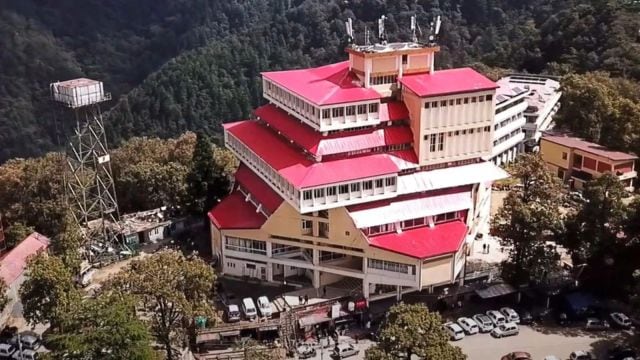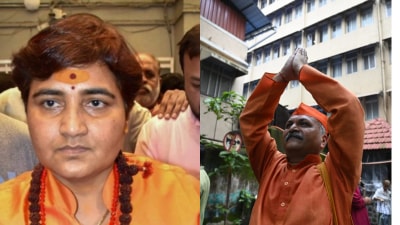Migrant workers in disasters: Himachal University student’s study uncovers gaps in relief policies in state
The study by a Himachal Pradesh University student explores how systemic responses can be redesigned to include migrant voices and address their realities.
 A detailed study by a student at Himachal Pradesh University (HPU) in Shimla has drawn urgent attention to the overlooked plight of migrant workers during disasters. (Photo: Himachal Pradesh University website)
A detailed study by a student at Himachal Pradesh University (HPU) in Shimla has drawn urgent attention to the overlooked plight of migrant workers during disasters. (Photo: Himachal Pradesh University website)At a time when Himachal Pradesh is grappling with disasters during the ongoing monsoon season, a detailed study by a student at Himachal Pradesh University (HPU) in Shimla has drawn urgent attention to the overlooked plight of migrant workers during calamities.
The study reveals a troubling reality: despite being among the most vulnerable sections of society, migrant workers remain on the fringes of disaster response and relief efforts.
Titled ‘Migrant Workers Must Not Be Ignored During Disasters’, the study by Itisha Parmar, a final-year student in MA (Social Work), draws four key findings: migrant workers are among the first to lose their source of income during disasters; they have no social safety net; commonly face mental distress and isolation; and have limited access to government aid.
“Despite various hardships, many migrant workers displayed remarkable resilience, navigating crises through peer solidarity, local support, and personal grit. This strength, however, often goes unrecognised in formal disaster planning,” the study notes.
The study explores how systemic responses can be redesigned to include migrant voices and address their realities, and raises a critical question: Are our disaster management frameworks truly inclusive?
The study, a part of the course curriculum, was submitted to Anupama Bharti, Assistant Professor, Department of Sociology and Social Work, on Wednesday. “We encouraged our researchers to work in fields which need more attention in times of crisis, especially issues like disasters and marginalised sections of society. Parmar’s research focuses on the most vulnerable section of society,” said Bharti, under whose supervision the study was conducted.
Parmar took assistance from Doers NGO, an organisation engaged in disaster relief, mental health support, and community rehabilitation in the state, and surveyed over 100 people.
‘They are more than just a labour force’
The study includes the profiles of people affected by disasters reported in the last five years in Himachal Pradesh. Since 2018, the state has recorded 148 cloudbursts, 294 flash floods, and over 5,000 landslides, a pattern that reflects the worsening climate volatility in the fragile Himalayan region.
On June 26 this year, at least seven migrant workers employed at a hydro project at Dharamshala were killed in a flash flood triggered by a cloudburst in Kangra district.
In last year’s Samej tragedy, when a series of cloudbursts hit the village, more than two dozen migrant workers were among the 39 victims who were washed away and later found dead.
Professor Shashi Kant, officiating chairperson of the Department of Sociology and Social Work, said, “It is a sad part of the story that we do not have any coordination with the state government in connection with the findings of our research. These findings can be very useful for policymakers if the government utilises them.”
Stressing on the role of social work education in bridging the gap between policy and ground realities, Parmar said, “Migrant workers are more than just a labour force — they carry the dreams of families, build the foundation of our cities, and keep local economies running. Their dignity, rights, and safety are a shared responsibility — one that must be reflected in our disaster response strategies.”
What the study found
- Livelihoods first to collapse: Migrant workers, mostly employed in construction, domestic work, agriculture, and hospitality — all unorganised sectors — are among the first to lose their source of income during disasters.
- No social safety net: A majority of migrant workers lack permanent housing, health insurance, or access to government social security schemes.
- Mental distress and isolation: Emotional trauma, anxiety, and social alienation are common, especially for those living far from their families.
- Limited access to government aid: Awareness of government schemes is low, and even when known, access is hindered by bureaucratic and logistical challenges.
What the study recommends
- Migrant-centric disaster planning: Relief and rehabilitation policies must explicitly include migrant workers as a priority group.
- Portable social security: Implement mobile, inter-state social protection schemes that recognise the identity and rights of migrant workers wherever they work.
- Better coordination: Enhance collaboration between local administration, NGOs, and community networks to ensure a timely on-ground response.
- Mental health integration: Incorporate psychosocial support and mental health care into disaster preparedness, with a focus on migrant populations.
- Training and awareness drives: Empower workers with knowledge about their rights, safety protocols, and access to aid through regular community outreach programmes.












